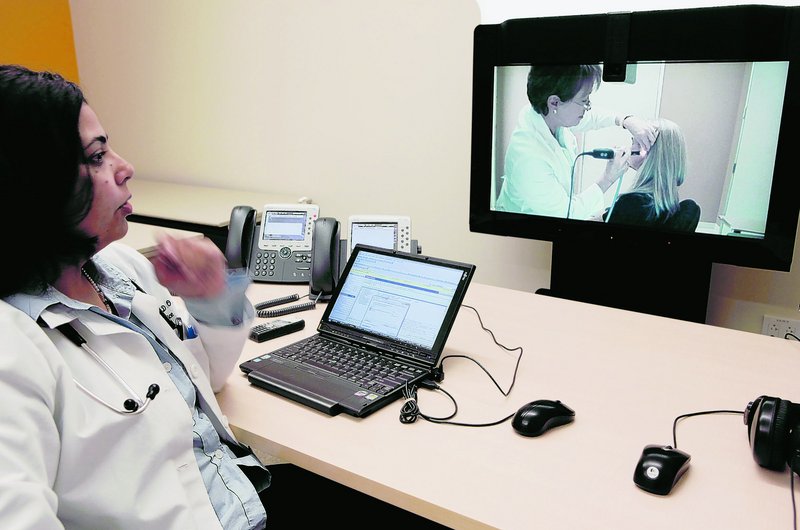SAN JOSE, Calif. – Working at the health center on Cisco Systems’ sprawling San Jose campus, Dr. Seema Sangwan examines dozens of Cisco employees a week — sometimes as they sit in a room nearly 3,000 miles away.
The busy internist sees patients at Cisco’s North Carolina campus without leaving California, using a high-end videoconferencing system that Cisco developed for health care use. Standing next to the patient, a nurse uses a high-resolution camera, electronic stethoscope and other devices to send the doctor close-up images and data, including heart rate and temperature, in real time.
“It’s amazing,” she said recently. “It really does feel almost like I’m sitting in the same room with them.”
Cisco didn’t just develop the technology for internal use. After conducting trials in San Jose, Scotland and France, the company recently announced that its HealthPresence video system and related technology are being used in new “telemedicine” programs offered by medical groups in Southern California and the Southwest.
Those programs are part of Cisco’s push to compete with other major tech companies, including Intel, IBM and General Electric, in the growing market for health care products and services.
They’re also part of Cisco’s broader strategy to promote and participate in wider use of digital video across numerous segments of daily life — which can only increase demand for Cisco’s core business of selling the networking equipment that carries those digital signals around the globe.
Cisco CEO John Chambers recently described telemedicine as a “vehicle for transforming health care on a global scale.” While the idea isn’t new, industry experts say the concept of offering medical services to patients in remote areas, by using the Internet and other telecommunications networks, is gaining wider adoption as major health care providers and insurers increasingly seek ways to serve more people at lower costs.
“Telemedicine is going to be everywhere. The only question is when,” said Dr. Jim Woodburn, an executive with UnitedHealthcare, the insurance company that is working with local health care providers to deploy Cisco’s technology in rural Colorado and New Mexico.
Several other companies, including Hewlett-Packard, Polycom and Teliris, sell high-resolution, commercial-quality videoconferencing systems, including some designed specifically for health care. But analysts say Cisco in particular is using its size and clout to accelerate adoption by medical providers and insurance companies.
“Cisco has the sales and marketing engine to really drive this forward,” said Ira Weinstein, who studies videoconferencing and related technology for Wainhouse Research.
Industry officials say that video systems can help fill a growing shortfall in the number of medical students choosing to become primary care doctors. One study by the Frost & Sullivan research firm estimated the market for telemedicine products and services in North America would grow from $900 million in 2007 to $6.1 billion in 2012.
One obvious use for video technology is delivering medical services to remote or rural areas, where patients would otherwise have to drive hours to see a specialist or even a primary care doctor. But experts say it can also be useful in big cities where, for example, a major hospital may have several satellite clinics but isn’t able to staff them with every medical specialty.
Experts say there are still obstacles to broader use of video to deliver health care, including medical licensing rules and regulations that in some cases restrict insurance or Medicare reimbursement for such services.
But studies show most patients become comfortable with video exams quickly, said Dr. Javeed Siddiqui, a telemedicine expert at the University of California-Davis Health System.
“I was pleasantly surprised,” said Shashi Kiran, a Cisco employee who participated in an early San Jose trial by getting a checkup from a doctor in Los Angeles. “It was really no difficult from visiting your doctor in person.”
Send questions/comments to the editors.




Success. Please wait for the page to reload. If the page does not reload within 5 seconds, please refresh the page.
Enter your email and password to access comments.
Hi, to comment on stories you must . This profile is in addition to your subscription and website login.
Already have a commenting profile? .
Invalid username/password.
Please check your email to confirm and complete your registration.
Only subscribers are eligible to post comments. Please subscribe or login first for digital access. Here’s why.
Use the form below to reset your password. When you've submitted your account email, we will send an email with a reset code.